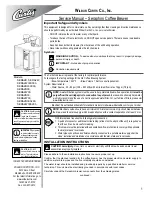
3-19
9. In the
Digital Output Panel
under
Channels
, click on an output
channel (channel
0
in this example) as shown in Figure 3-8.
Figure 3-8. Configuring channel 0 for output bit pattern A
10. In the
Digital Output Panel
under
Output Bits
, set the bits of
channel
0
for bit pattern A as shown in Figure 3-8.
11. Measure the voltage between signal ground and each bit of the
output port with a DMM or DVM. Make measurements at the
cabled mating connector of your accessory.
12. Each bit set to ON in the
AIO Panel
should output a logic-high sig-
nal at the corresponding I/O terminal, reading typically about
4 volts (minimum of 2.2 volts) at a DMM/DVM. Each bit set to
OFF in the
AIO Panel
should output a logic-low signal at the corre-
sponding I/O terminal, reading typically about 0 volts (maximum of
0.8 volts) at a DMM/DVM. Do one of the following:
Note:
The typical values shown are valid for boards with TTL
compatible outputs. For boards with relay outputs (REL-16, PDISO-8,
and PIO-32) the output will be a relay contact closure. For boards with
open collector outputs (PIO-HV) use a pull up resistor to an appropriate
voltage to detect output state. Refer to the hardware description in this
user’s guide for more details on the output’s electrical specification.
●
If the bit patterns set on the
AIO Panel
do not agree with the
logic levels measured at the I/O terminals, the board is not
functioning properly. Stop here, and determine why.
●
If the bit patterns set on the
AIO Panel
agree with the logic
levels measured at the I/O terminals, then repeat steps 9, 10, and
11 for remaining output channels.
KEITHLEY
Digital Output Panel
Channels
0
1
2
3
4
5
6
7
7
6
5
4
3
2
1
0
8
9
10
11
12
13
14
15
Output Bits
55
















































